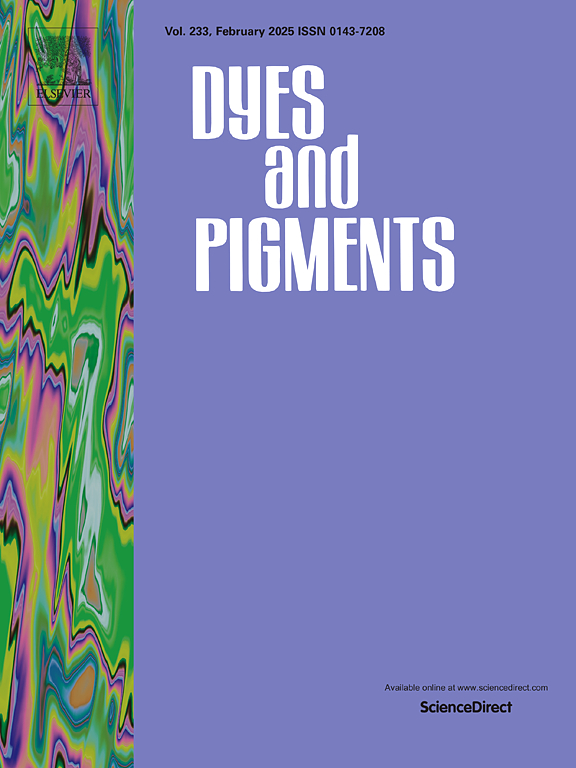对BODIPY染料光物理行为的计算见解:取代基对辐射和非辐射衰变途径的影响
IF 4.1
3区 工程技术
Q2 CHEMISTRY, APPLIED
引用次数: 0
摘要
本研究提供了一系列具有苯基、萘基、蒽基和芘基取代基的BODIPY衍生物(BDPA: P1-P4)的光物理行为的计算见解。通过密度泛函理论(DFT)和自旋翻转时间依赖DFT (SF-TDDFT),我们系统地研究了这些取代基如何调节电子结构、吸收/发射特性和电荷转移过程。结果表明,虽然BODIPY核主要决定前沿轨道分布,但取代基的性质引起HOMO和LUMO能量的系统位移,改变电荷转移长度,并显著影响辐射和非辐射复合动力学。辐射复合率与跃迁偶极矩密切相关,其值从BDPA:P3的0.82 × 108 s−1到BDPA:P1的3.81 × 108 s−1不等。相比之下,非辐射衰变通过两个相互竞争的通道发生:锥形相交为BDPA:P1, BDPA:P2和BDPA:P3提供了有效的衰变途径(激活势垒在27.6和32.2 kJ/mol之间,导致衰变速率为107 s−1),而内部转换在BDPA:P4中更加明显。这些发现强调了取代基工程在调整BODIPY染料在有机发光二极管(oled)和染料敏化太阳能电池(DSSCs)中应用的光物理性质方面的潜力。本文章由计算机程序翻译,如有差异,请以英文原文为准。
Computational insights into the photophysical behavior of BODIPY dyes: The impact of substituents on radiative and nonradiative decay pathways
This study provides computational insights into the photophysical behavior of a series of BODIPY derivatives (BDPA:P1–P4) with phenyl, naphthyl, anthryl, and pyrenyl substituents. By employing density functional theory (DFT) and spin-flip time-dependent DFT (SF-TDDFT), we systematically investigated how these substituents modulate the electronic structure, absorption/emission characteristics, and charge transfer processes. Our results reveal that although the BODIPY core predominantly determines the frontier orbital distributions, the nature of the substituents induces systematic shifts in HOMO and LUMO energies, alters charge transfer lengths, and significantly influences the radiative and nonradiative recombination dynamics. Radiative recombination rates correlate strongly with the transition dipole moments, with values ranging from 0.82 × 108 s−1 for BDPA:P3 to 3.81 × 108 s−1 for BDPA:P1. In contrast, nonradiative decay occurs through two competing channels: conical intersections provide an efficient decay pathway for BDPA:P1, BDPA:P2, and BDPA:P3 (with activation barriers between 27.6 and 32.2 kJ/mol leading to decay rates on the order of 107 s−1), whereas internal conversion becomes more pronounced in BDPA:P4. These findings underscore the potential of substituent engineering to tune the photophysical properties of BODIPY dyes for applications in organic light-emitting diodes (OLEDs) and dye-sensitized solar cells (DSSCs).
求助全文
通过发布文献求助,成功后即可免费获取论文全文。
去求助
来源期刊

Dyes and Pigments
工程技术-材料科学:纺织
CiteScore
8.20
自引率
13.30%
发文量
933
审稿时长
33 days
期刊介绍:
Dyes and Pigments covers the scientific and technical aspects of the chemistry and physics of dyes, pigments and their intermediates. Emphasis is placed on the properties of the colouring matters themselves rather than on their applications or the system in which they may be applied.
Thus the journal accepts research and review papers on the synthesis of dyes, pigments and intermediates, their physical or chemical properties, e.g. spectroscopic, surface, solution or solid state characteristics, the physical aspects of their preparation, e.g. precipitation, nucleation and growth, crystal formation, liquid crystalline characteristics, their photochemical, ecological or biological properties and the relationship between colour and chemical constitution. However, papers are considered which deal with the more fundamental aspects of colourant application and of the interactions of colourants with substrates or media.
The journal will interest a wide variety of workers in a range of disciplines whose work involves dyes, pigments and their intermediates, and provides a platform for investigators with common interests but diverse fields of activity such as cosmetics, reprographics, dye and pigment synthesis, medical research, polymers, etc.
 求助内容:
求助内容: 应助结果提醒方式:
应助结果提醒方式:


